The redesigned 2019 Ram 1500 is big, capable and nice to look at. On paper, it seems like an adept family car considering how many toys, consumables (diapers) and other assorted baby-related flotsam most parents find themselves traveling with. But the Ram is also utilitarian by nature, and did I mention big?
(Full Disclosure: Ram let me borrow this truck for a week, and had it dropped off with a full tank of gas.)
There’s lots of space inside and out. Who doesn’t want to cart the baby’s junk outside in a box that’s big enough to be its own swimming pool? Of course, there’s more to it than that, and a lot of it comes down to personal taste and available resources.
I must preface a review of such a large machine as a family car by saying that the minivan is the benchmark by which all family cars should truly be measured. Nothing before or since the minivan has been as well-suited to a family’s needs in terms of space, comfort, fuel economy and even disposability (no one’s keeping the family Sienna for the grandkids.) But let’s say you have a boat or a travel trailer to haul and still need room for craploads of diapers, toys and “useful” things your mother-in-law gave you when you visited over the weekend. This is where something like the Ram 1500 can come in pretty handy. Sometimes.
I took my family to Washington, D.C. to celebrate [insert spring equinox-based religious holiday of choice] with the rest of my family. I was able to accommodate wife, child and aforementioned mountain of junk with ease in the four-door Ram 1500 Limited. And all of the stuff (not the wife and kid, obviously) would have fit in the bed were it not for a weather forecast that called for rain.
No cap or tonneau cover means that anything you’re carrying that can’t get wet–which includes most things besides yard waste–rides inside with you and your family. Other drawbacks included highway fuel economy that wasn’t exactly as-advertised, and the fact parking was a bear. Like all full-size pickups these days, the Ram 1500 is gigantic.
But the family was comfortable and didn’t complain, and that counts for a lot.
Cabin & Cargo
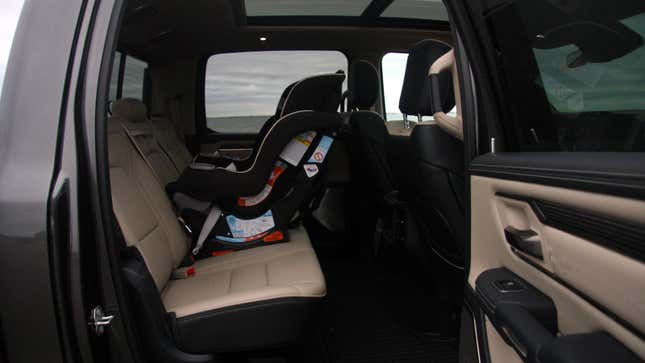
This Ram Limited’s interior is comfortable–perhaps even more comfortable than any truck has a right to be, if you grew up with the basic work trucks of the 1990s and every one that came before. Some of the material choices rival luxury vehicles.
Naturally, the cab of this truck is very roomy, and incorporates lots of convenient little cubby holes (including drinks-and-ice-ready wells in the floor of the back seat) for stashing things you don’t want to lose inside a cavernous interior... although to be fair, it also presents a lot of new places to lose things. For example, I considered using one of the floor cubbies to stash the baby’s milk bottles with some ice packs. But here’s the thing: I find those things all over the house (and cars) in all kinds of “convenient” stash spots, usually with month-old milk moldering at the bottom. The diaper bag comes with a pouch for them, so the cubbies stayed empty until I could think of something to put (lose) in them.
The Ram 1500 is one of the few vehicles on the market outside of Korean executive sedans that offers enough rear seat legroom to give tall passengers a chance to really stretch out. The back seat is huge, which makes it really easy to get a child safety seat situated back there, too. I never had to carry any tall passengers, but if I had, they would have been comfortable.
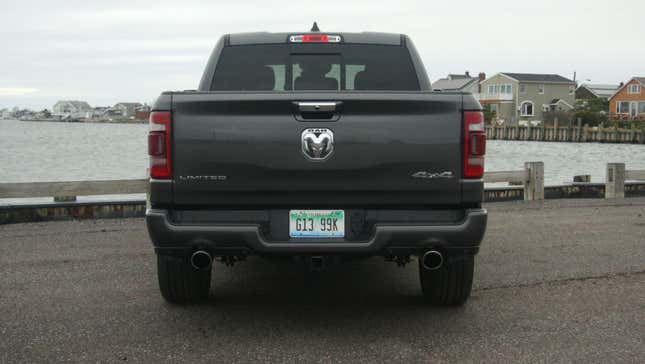
Interior fit and finish is good, although the Ram’s interior incorporates a level of syrupy nostalgia that evokes 1960s Nashville’s penchant for country porch stage sets and sequin-bedecked riding attire. As if to reinforce how American the truck is, Ram’s interior decorators saw fit to install campy decorative devices everywhere there was space. “I out-American every American this side of Americana,” the cowboy saddle stitching all over the console, doors and seatbacks seem to say.
There are so many different varieties of Americanness available in the Ram’s interior–including rough barnwood trim panels–that it can seem incongruous, as when someone decorates an old barn with all the old junk they bought at various ranchers’ estate sales. Fortunately, babies don’t care about such things, and will drool on expensive barnwood accents or cheap plastic without prejudice.
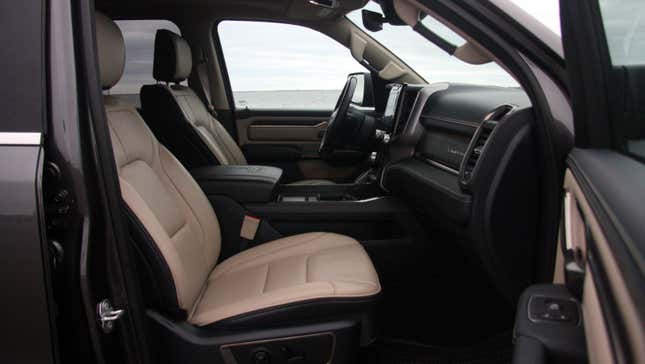
But it’s well executed if nothing else, and could probably be considered the spiritual descendant of the paisley interiors of the 1970s land yachts. It doesn’t distract much from driving comfort, at any rate.
I have mixed feelings about the Ram Boxes–those lockable loading cubbies in the sides of the bed you can get for an extra $995. They are handy–each one could fit an umbrella stroller and a bunch of other odds and ends. And they come with drains, so you can fill them with ice and use them as (uninsulated) coolers if you want to. But they also cut into bed volume in a very real way. I found that out the hard way when I was trying to stuff a pile of yard waste into the space. Despite the minor squeeze in cargo volume, there isn’t much Costco can throw at you that wouldn’t fit in the back of a Ram Box-equipped 1500.
Driving & Fuel Economy
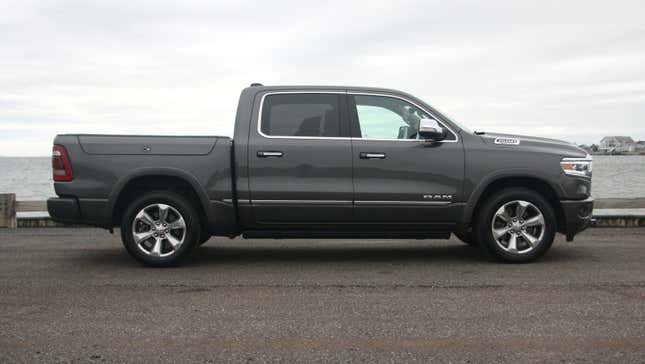
Once you get used to the Ram’s bulk, it handles pretty well. For something designed to carry so much weight, it offered a smooth ride on the highway, although bumps around town were a bit more pronounced than in a passenger car due to the heavy axles and springs made to take the abuse of heavy loads. Acceleration is strong, which is not surprising from a V8 that cranks out more than 400 lb-ft of torque.
One of the most novel gadgets available on the new Ram–depending upon the model you get–is the electronic ride height selector. The suspension system senses when someone is about to climb aboard and lowers the truck to ease entry.
It’s a useful device for any parent dealing with an unwieldy armload of baby and baby junk. Vaulting into an extra-tall truck isn’t so easy in this condition. The truck also squats when the side storage boxes are opened. There’s a normal default height, a raised off-road setting, and an aero mode that lowers the truck at highway speeds to help lower its profile and, supposedly, conserve fuel.
Despite all the gadgets, driving the big Ram around town was often stressful. It seems many parking lot designers didn’t foresee anything drafting more than 20 feet in length and nearly 7 feet in width attempting to utilize car-sized stalls.
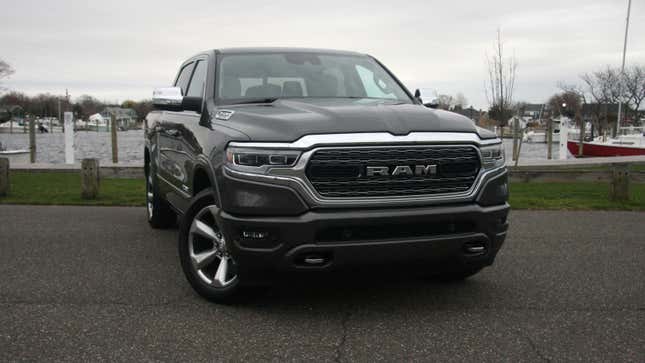
And when you’re neck-deep in parenting, you often find yourself nosing a vehicle into the parking lot of one of the sort of consumerist time-sucks that require parking lot agility. The Ram’s 82 inches of width can make it difficult to extract wriggling offspring from the back seat when the door can be only partially opened in a narrow parking space. This happened to me multiple times, and I imagine it would be a regular feature of a Ram-owning parent’s experience, to say nothing of awkwardly nosing the truck into and out of spaces without enough clearance for a wide turn-in radius.
There are, of course, people who live in the country’s more sparsely populated regions where there’s probably a lot more space to park big trucks, but statistically, most of us live in cities and suburbs. And if you can lease a giant pickup truck for a few hundred dollars a month, you’d better believe that a good chunk of the 2 million or so full-size pickups sold last year ended up in congested places where they’re pushing the limits of where they’re expected to fit.
The Panama Canal was dug deeper to accommodate larger ships... Can’t we expect congested shopping centers to do the same? Perhaps not.
Fuel economy, as you would expect, isn’t great in the Ram 1500. Despite the EPA label claim that this truck would get 22 mpg on the highway, I got 18 on a trip to Washington, D.C. from New York City, according to the truck’s trip computer. Mileage was even worse around town: usually between 15 and 16 mpg. Maybe I wasn’t hypermiling enough, but I was underwhelmed.
Safety

The Insurance Institute for Highway Safety (IIHS) gave the new Ram top marks in its battery of crash testing. It didn’t make the Top Safety Pick cut, though, and got dinged for its headlights (“Marginal”) and LATCH child safety seat anchors (also “Marginal”). IIHS rates LATCH anchors based on ease of use, and since I never bother with the tether anchor–which IIHS techs said was difficult to find–I didn’t have much problem securing my son’s child safety seat.
The lower anchors were a little deep in the center seating position, but a lack of seat contours (it’s probably one of the last true “bench” seats on the market) and a decent sized gap between the seat and seatback made for easy latching into the LATCH anchors.
The federal government gave the crew cab four-wheel drive model four out of five stars in its crash testing regiment. It scored four out of five stars in front crash testing, but only three out of five stars in the rollover test. The government has not yet tested it for side impact crashworthiness, although IIHS said it tested well. For some reason, rear wheel-drive regular cab Ram 1500s fared better in federal side impact testing than the quad and crew cab models – not that many consumers will buy those.
Verdict
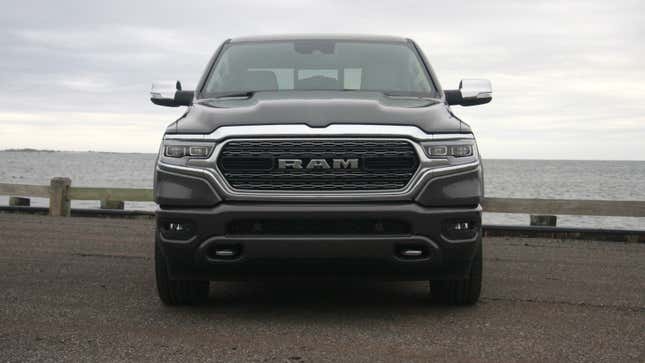
In spite of its somewhat campy interior design elements, the Ram 1500 is a handsome truck with a lovely dash layout, an easy-to-use infotainment system and plenty of interior space for a typical 1.9-child family.
It’s nice, but that luxuriousness costs plenty–both in cash and daily usability if you have to park anywhere remotely tight. The Limited trim version I tested came with heated and cooled leather seats, a gigantic 12-inch center stack touchscreen, power adjustable pedals, power folding mirrors, a gorgeous panoramic sunroof and a 19-speaker Harman Kardon audio system, among other goodies while the sticker price closed in on $70,000. That’s luxury car territory.
Add in the truck’s abysmal fuel economy and parking lot-abhorrent width, and you have something that wouldn’t be a very practical family car for most people (especially considering the average household income in the US is just over $61,000). In other words, it’s no minivan.
But if you’re one of those parents who has the need for space, luxurious comfort and the ability to tow big, heavy things – and you have enough money to pay for a $50,000 to $70,000 vehicle and all the fuel it consumes while still contributing to junior’s college fund–the Ram 1500 could be a nice way to get around.
Sure, your barnwood interior will look like it has had actual animals living in it after your little ones are done smearing various gooey substances all over it for several years, but just think of all the wet wipes you can haul in a bed that can accommodate almost 2,000 pounds worth of crap.